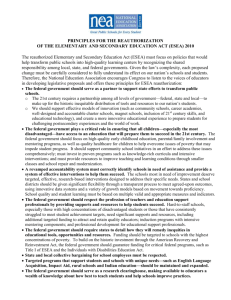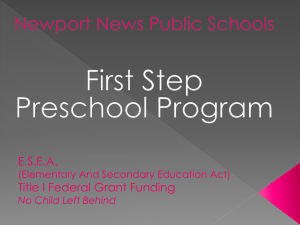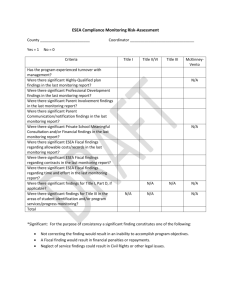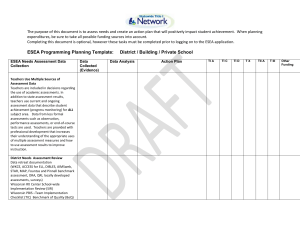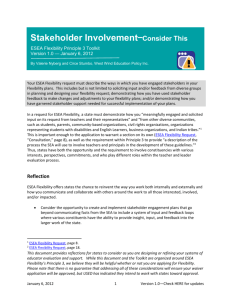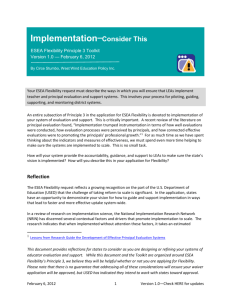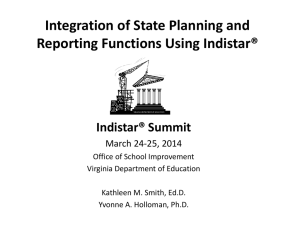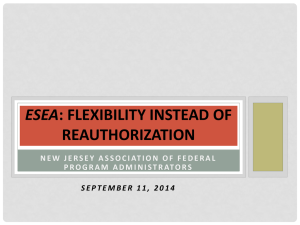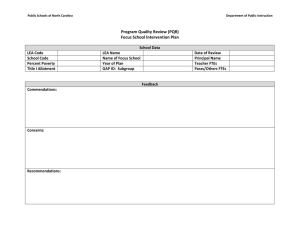Conducting a Comprehensive Needs Assessment
advertisement
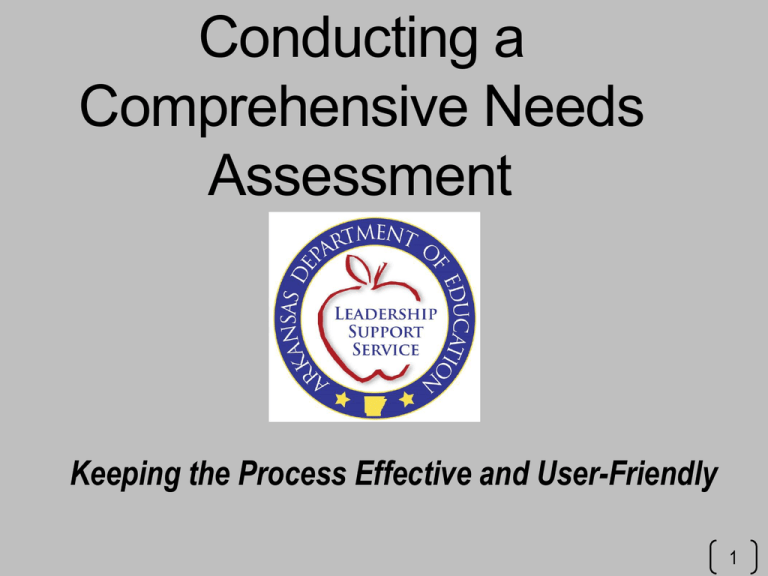
Conducting a Comprehensive Needs Assessment Keeping the Process Effective and User-Friendly 1 Since change is made by individuals, their personal satisfactions, frustrations, concerns, motivations, and perceptions all contribute to the success or failure of a change initiative. ---Loucks-Horsley &Stiegelbauer, 1991,p.18 (Love, 2008) Page 316 Figure 7.2 Swingset Cartoon 2 PURPOSE By the end of this session, we will: • develop a picture of what needs assessment processes can look like. • use tools and a process to conduct a comprehensive needs assessment that will lead the building to take action and drive the development of the School Improvement Plan Source: Implementing Change: Integrating Policy, Research and Context to Benefit Students – Denise Ariola (2014) and Questions for Life Powerful Strategies to Guide Critical Thinking - Stephen G. Barkley (2009) 3 What is a Needs Assessment? A comprehensive needs assessment is a process organizations and schools use to: 1. Identify gaps between current conditions (what is) and desired conditions (what should be); 2. Place these gaps or needs in priority order; 3. Implement interventions, action, strategies and practices aligned to needs; 4. Target resources to address needs. ESEA Flexibility; USDOE- Title I, Part A 1114; ADE Federal Programs and School Improvement Units 4 Step1: Conduct a Needs Assessment - Consider the Mission Statement and use a variety of data to determine where the school is currently and compare where the school wants to be. Step 2: Determine the Priorities, Goals , Benchmarks & interventions based on disaggregated data which focuses on student needs. Step 7: Monitor & Evaluate interventions for effectiveness. Step 6: Peer Evaluation Step 5: Implement Interventions & Actions Step 3: Design evidence based actions geared towards enhancing student achievement. Step 4: Apply the appropriate funding sources to the actions that require state or federal funding. Source: Roy, P. (2004). A Tool Kit for Quality Professional Development in Arkansas ADE, School Improvement Unit Needs Assessments can also be referred to as… Tools that can be used to develop a needs assessment: 1. Comprehensive Needs 1. Indistar® 2. Multiple measures of data• Perceptual • Student Learning • School Process • Demographic 3. AMO results 4. Interim Assessments 5. Scholastic Audit 6. TESS 7. Focus Groups & Teams 8. CWTs and Focus Walks Assessment • Root Cause Analysis • Scholastic Audit 2. Strategic Planning ESEA Flexibility; USDOE- Title I, Part A 1114; ADE Federal Programs and School Improvement Units 6 Step-by-Step Process 1. Establish a Leadership Team and sub teams or committees based on needs 2. Clarify the Vision and Mission for reform 3. Create the school profile 4. Identify data, research, resources 5. Analyze the data ESEA Flexibility; USDOE- Title I, Part A 1114; ADE Federal Programs and School Improvement Units 7 Step 3: Creating the School Profile Focus Area 1. Change in Teacher & Leader Practice 2. Student Progress and Achievement 3. Student Safety & Discipline 4. Family & Community Engagement 8 Step 3: Create a School Profile by completing a Comprehensive Needs Assessment School Profile 1. Change in Teacher and Leader Practice 2. Student Progresses and Achievement 3. Student Safety and Discipline 4. Family and Community Engagement Research, Resources, and Data Start the process and develop the School Improvement Plan (SIP) to address the gap between the Current status and Vision. Where is the school now within the focus area? Where do we want to be? • • • per quarter/nine weeks Semester end of the year ESEA Flexibility; State Personnel Development Grant (SPDG) http://www.arstudentsuccess.org/ ; *USDOE- Title I, Part A 1114 9 The Leadership team and other stakeholders complete a Comprehensive Needs Assessment • per quarter/nine weeks • Semester • end of the year Research, Resources, and Data School Profile Determine Focus Areas (IMOs) Where is the school now within the focus areas? 1. Change in Teacher and Leader Practice Identification and Analysis Start the process and develop the School Improvement Plan (SIP) to address the gap between the Current status and Vision. Where do we want to be? *Curriculum and Instruction( *Professional Development *School Context and Organization PLCs Leadership Team 2. Student Progresses and Achievement PLCs *Student needs 3. Student Safety and Discipline Safety Team 4. Family and Community Engagement *Involvement Family & Community Team ESEA Flexibility; State Personnel Development Grant (SPDG) http://www.arstudentsuccess.org/ ; *USDOE- Title I, Part A 1114 10 Thank you for participating in the Comprehensive Needs Assessment Session! School Improvement Unit For more information contact your: School Improvement Specialist (501)-683-3434 http://www.arkansased.org/divisions/learning-services/school-improvement Presenters: Dr. Mitzi Smith Ms. LaDonna Spain mitzi.smith@arkansas.gov Phone: 501-682-4585 Cellular: 501-209-9733 Fax: 501-683-3433 ladonna.spain@arkansas.gov Phone: 870-367-4836 Cellular: 501-580-9715 Fax: 870-367-9877 11
